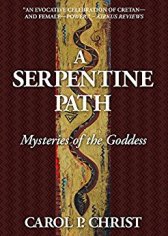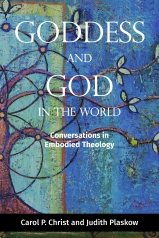 Our first ritual on the Goddess Pilgrimage to Crete is a death ritual in which we honor the memory of those who have gone before us. Like so many things on the pilgrimage, the death ritual evolved. I did not consciously plan to begin with death. Rather, the death ritual inserted itself at the beginning of the tour. Now I understand that the timing is right.
Our first ritual on the Goddess Pilgrimage to Crete is a death ritual in which we honor the memory of those who have gone before us. Like so many things on the pilgrimage, the death ritual evolved. I did not consciously plan to begin with death. Rather, the death ritual inserted itself at the beginning of the tour. Now I understand that the timing is right.
As we begin our pilgrimage, seeking new insight about the meaning of our lives, about the meaning of life and death, we pause to remember those who have gone before us.
Before the ritual begins, I discuss the communal burials in round tombs of the ancient Cretans, sharing my belief that the purpose of their rituals was not to secure immortality or eternal life for the individual, but rather to affirm and ensure the regeneration of life in the community and in nature. I add that though I have no desire for personal life after death, I care deeply about the continued flourishing of life for human and other than human beings.
I like to keep rituals simple. First, we create an altar. Two stones mark the place. We decorate them with flowers and fruits from our Mother Earth and small images of the Goddess.

Then, we pour libations of milk and honey, water and wine, naming those we have lost to death:
“Remembering Mama and Aunt Mary Helen, Grandma and Grandpa, Nannie and Pop, my baby brother Alan, Aunt Lorraine and Uncle Ed, Uncle Dave, Uncle Dick and Aunt Jeanne, Judy Mings, Emi Dimopoulou, Mr. Nikos who helped us in the Skoteino Cave, Mr. Haralambos and little Arseni, my little dog Matakia, and many others whom I have loved.”
As each woman speaks the names of those who have loved her, the stones glisten with water, with red and white wine, with golden honey, and with white milk. Some of the women lose their voices; others are overcome with tears.
As each woman finishes, the group responds: “Let us bless the Source of Life, and the cycles of birth, death and regeneration.”
The movement of the women two and fro from altar is itself a kind of dance; the gesture of pouring liquids that flow into the earth is a physical embodiment of our gratitude for all that we have been given.
When each woman has spoken and poured libations, the group sings “She Carries Me” by Jennifer Berizan, with the refrain: “She carries me, She carries me. She carries me to the other side.” My throat always catches on the line “with broken wings, I reach to fly …” Almost always a pair of buzzards circles overhead.
We “drink the wine of regeneration” from a chalice and “taste the sweetness of life” in the form of a nut dipped in honey.
We close the ritual with a simple 1-2-3 circle dance creating snakelike patterns, in and out, around the altar, ending in a spiral dance, in and out again, as we sing: “The darkness and the light meet inside of me and they dance me into life, set me free, set me free.” At the end of the ritual, we are standing together in a circle raising our hands to the sky above, chanting, “set me free, set me free.”
There is more to the ritual we create in Crete, but I have shared the elements that can be repeated anywhere. It is deeply meaningful to begin our pilgrimage remembering those whose lives have made ours possible, bringing us together on the journey. Blessed be.

* * *
Carol’s new book written with Judith Plaskow, is Goddess and God in the World: Conversations in Embodied Theology.
FAR Press recently released A Serpentine Path: Mysteries of the Goddess.
Join Carol on the life-transforming and mind-blowing Goddess Pilgrimage to Crete. Space available on the spring and fall tours!




So beautiful! Thank you, Carol.
LikeLike
Beautiful ritual and it makes so much sense to me to begin with death because it is the end of life – endings seed beginnings.
LikeLike
Bright blessings to you and to all the women who travel with you, literally or metaphorically.
I don’t know about my next death, but I’ve recently decided I’m going to come back in England and move as early in my next life as I can to Stratford-upon-Avon so I can work with the Royal Shakespeare Company.
LikeLike
Thank you for this thoughtful post, Carol. Wish I could be in Crete with you to join in the ritual. I don’t believe in an afterlife, but find myself feeling annoyed and upset when I think about the nothingness beyond. I want to see what my grandchildren make of their lives. I also would like to know that they and their parents and everyone else will be okay.
But that’s out of my control, of course.
LikeLike
I don’t have children and grandchildren, but I do hope the web of life survives without major disasters which seem to be in the offing. I don’t think of dying as nothingness, because I accept that individual lives have a beginning and and ending. I like to think that we step aside to give our places to others.
LikeLike
A wonderful post and a lovely ritual for remembering that we in this generation are not alone, but stand shoulder to shoulder with generations of strong, loving, peaceful, amazing women who came before us and generations of strong, loving, peaceful, amazing women who will, if we make it past this point in the history of humanity, come after us.
LikeLike
The last traces of the old Mother God belief system were found in Yemen. The Stones of Destiny, believed by the ancients to have fallen from Venus, were meteorite fragments(or stones formed from an impact event) that were shared among the mother churches of the ancient world, but are now held hostage in the capitals of Patriarchal folly. The only one we know about is the one in the Ka’aba in Mecca, which was stolen from the Yemeni temple of the triple goddess Al-ʻUzzā, destroyed by Mohammed. Look at the yoni on the corner of the Ka’aba, which the men dance around, celebrating their imprisonment of the female spirit. The image of the goddess held prisoner can be seen in the concept of both the Shekinah and the Shakti, and later the Sophia, and today is celebrated manifestly in the vile tradition of the Kumari in Nepal. But the most violent, most vile symbolism is undoubtedly in Mecca.
This Venus Stone, once worshipped as the embodiment of the Mother God, is now known as Abraham’s footstone, “softened under his feet.”
Saudi Arabia has forbidden archaelogy for obvious reasons, they will not even allow the female form to be on display in their museums!! SA is currently bombing the UN heritage site of the temple of the Marib, thought to have had historical connections to the legendary Queen of Sheba who the people still sing songs to to this day. Don’t believe the propaganda on Wikipedia or on CNN saying it is the Houthis/Al Qaeda doing the bombing- SA are funding AQ (read the years of work by Patrick Cockburn in the Independent.uk) and it is their bombs that are killing Yemen, and starving their children to death. SA want to destroy our history, to finish off what the Roman and British Empires may have overlooked in their carnage.
The Black Stones were in the underground caverns of the Oracles and in the Temples of Jerusalem, Tyre and Carthage (after Crete’s civilization was destroyed with the Bronze Age collapse and Aryan/Macedonian Patriarchy ascended in their colony of Greece, as Aryan Zoroastrianism would in the Levant and Egypt.) Yemen were the last hold-outs of Matriarchy, all the way to the 6th century, and still practiced the original First Temple form of Judaism, which was a Mother God religion, before the Pharisees betrayed it – read the Song of Solomon, the book of Venus, and look at the thousands of Asherahs that are the only trace of worship in the ancient towns and villages of the Levant. Still no evidence of YHWH!! The Menorah is the Female Tree of Life, symbol of feminine cultivation.
The Black Madonnas that are currently found around Europe and are believed to be of North African origin (mostly fake) are the last vestige of the worship of the Black Venus Stones in the Christian tradition, that tradition which had tried to restore First Temple theology but like so many others, up to the present, were/are the victims of Rome.
Wear a black stone always and meditate for the women of the Middle East, particularly The Yemen.
Black is the sky, Black holds and moves the stars. Black is the medium of life, through which one sees the energy of the universe.
Carry a black stone with you to remind you of your ancient mothers. The lost ones.
Burn Frankincense for Al-ʻUzzā, Allāt and Manāt.
May the Usurpers fall, May the Daughter Rise.
LikeLike
Thank you for sharing that beautiful ritual, Carol.
LikeLike
This was such a powerful ritual when I was on your tour in 2015, Carol, especially doing it on my Birth Day, and being without my Mother in the world. . . I was grateful to be able to honor her that day in the company of women at a sacred place.
LikeLike